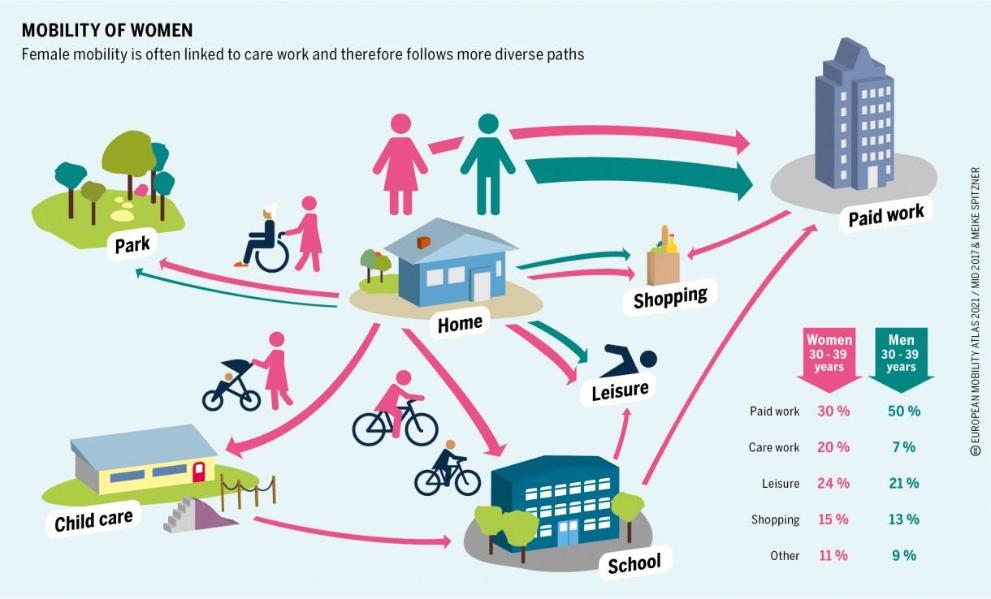Here’s how JASPERS advises Andalusia in its efforts to shape transport solutions for women and families
By Alberto González Sánchez, Maja Roginska and Carmen Niethammer
The transport sector is a key enabler of our societies, allowing for the interconnection of people, goods and ideas. Currently, the transport sector is facing the challenges of sustainability, digitalisation and modernisation, as well as resilience.
Women are the key actors in sustainable mobility and the predominant users of sustainable transport modes. The 2011 Andalusian Social Survey regarding mobility in metropolitan areas finds that 65% of public transport users in Andalusia and 59% of pedestrians are women. When it comes to car use, women are less likely to take the wheel than men (41% vs 59%), tending to be the car passenger (71% vs 29%).These results are confirmed by more recent studies, such as the Metropolitan Transport Plan of Granada and the Feasibility Study for the Extension of Granada Metro (both underway). According to the Feasibility Study, 65% of Granada Metro users are women.
The purposes of the trips and, therefore, the transport needs of men and women also differ significantly. According to the Andalusia data, women do the majority of trips to accompany children (65%) and to shop (63%), as well as health-related journeys (61%). Men are predominant when it comes to work trips (58%), business-related trips (81%), and leisure trips (58%).

The success of sustainable transport plans and mobility strategies requires a recognition that the majority of users are often female and, therefore, that women should be put at the centre of the planning process to make sure that their needs are properly addressed. Moreover, women are typically not only the primary users of sustainable mobility (public transport, walking) but have been found to pay more attention to potential environmental and related ecological issues. They are, as a result, more inclined to switch to sustainable transport modes1.
1. Where does the main challenge lie?
Transport systems are a catalyst for economic growth, and transport-related spending amounted to about 2% of global GDP in 2015. Importantly, transport provides people (women and men) with access to jobs, education, and healthcare. It also connects goods and services to markets, and is a key driver of growth.
While women are the biggest users and main champions of sustainable mobility, this is often not reflected in transport plans, strategies and projects. To correct this problem, the needs of women have to be considered separately, including in particular:
- Travel characteristics and expectations: the combination of overall different trip patterns, purposes, modes and travel times. A woman (or man) walking together with small kids to school is likely to value the street’s safety (and therefore, traffic calming measures) more than a man (or woman) driving during rush hour to arrive on time for an important meeting.
- Physical requirements: from the height at which infrastructure is installed (as women, on average, tend to be shorter than men) to accessing sanitary facilities.
- Safety concerns: As reported by the European Institute on Gender Equality, “women are more concerned than men about their safety while travelling. For example, women prefer not to travel at night, when lighting is poor, for fear of physical and/or sexual assault. Similarly, overcrowded public transport can increase the risk of sexual harassment,” influencing the travel choices women make.
- Participation in the labour market: At the European level, 67% of women are currently in employment, whereas men’s employment stands at 79%. In other words, there is a gender employment gap of 12%2. In the transport system, only 22% of the workforce are women – most of them in administrative positions with less than 5% working as pilots, seafarers and track or train drivers3. In the case of Andalusia, 17% of the workforce in land transport are women4.
- The 2019 Report on violence against women working in transport, based on a survey of European transport workers, highlights alarming evidence of high levels of violence against women at work across Europe. Twenty-five percent (25%) of the women interviewed believe that violence against women is a regular occurrence in the transport sector, and 26% believe that harassment is considered ‘part of the job’ in the transport sector.
Addressing these issues is key for the Regional Government of Andalusia and the European Investment Bank. The Andalusian legal framework, through its Law on the Promotion of Gender Equality5, considers the gender equality component in transport system planning.
“Women’s talent and ability are key to achieve our commitments with the economic recovery, sustainable development and the transition to carbon neutrality,” says Marifran Carazo, Minister of Infrastructure Development for the regional government of Andalusia. “To continue breaking the glass ceilings is not only fair, but also our obligation in pursuing a stronger society. Our right to equality does not lie in the fact that we can be brave, capable or competitive, but in the mere fact of being human.”
From the European Investment Bank perspective, gender equality is one of the core values of the European Union, and a key objective of the Sustainable Development Goals.
“Gender equality is a core principle of the European Union, but it is not yet a reality,” said Ursula von der Leyen. “In business, politics and society as a whole, we can only reach our full potential if we use all of our talent and diversity. Using only half of the population, half of the ideas or half of the energy is not good enough,” she said
In 2016, the EU bank approved the first EIB Group Strategy on Gender Equality and Women’s Economic Empowerment. The Gender Action Plans that followed guide the implementation of the strategy. On top of this, the European Investment Bank recognises the importance of addressing gender considerations in any project it supports.
“Women are an essential part of the climate solution: they are more likely to start sustainability-focused businesses, to improve energy efficiency and invest in renewables,” says EIB President, Werner Hoyer. “Yet, despite the significant positive impact they can make, women face substantially more difficulties in accessing financing for their investment activities. This is where the EIB can make a difference.”
Women are an essential part of the climate solution: they are more likely to start sustainability-focused businesses, to improve energy efficiency and invest in renewables

2. Re(solution): Planning and Designing for Women’s needs
Tackling gender equality in the transport sector requires tailored solutions designed to address the specificities of each location, based on robust analysis and diagnosis, including sex-disaggregated user data. The solution must be multifaceted and aligned with the objectives of an overall gender equality strategy. Here are a number of gender-oriented measures that can serve as examples regarding transport needs, security, affordability and the transport workforce:
- Collecting and analysing sex-disaggregated user data to properly understand the needs of both women and men using the transport system.
- Measures addressing the different transport needs should address the physical elements (infrastructure, accessibility, gender-responsive physical design) as well as the provision of public transport, for example by increasing frequencies outside peak-hours or modifying transport routes to ease access to schools, day-care centres and grocery stores. All these should be designed based on thorough consultations with various users of all genders, age groups, ethnicities, etc.
- Improving the security of the public transport system can be achieved by a number of measures, such as lighting and CCTV, female security staff, emergency panic buttons or apps, extra “at-request stops”, relocation/re-urbanisation of isolated public transport stops, etc. Furthermore, a key element is the education of staff on how to respond to situations of (sexual) harassment, and how to address complaints of harassment from users. Finally, collecting data on violence and harassment, including its location, and encouraging its reporting should allow for better targeting of potential additional measures.
- Women are typically the primary users of public transport, as was exemplified in the case of Andalusia. When combined with the overall lower participation of women in the labour force, the affordability of the public transport system appears as a key issue to ensure gender equality. Measures addressing the affordability of the transport system may include monthly/annual passes, subsidies and discounts for specific groups, and setting a maximum cost of public transport for families (for example, depending on the number of working adults living in a household).
- Ensuring access to sufficient, clean and safe sanitary facilities is an important factor for women or people traveling with children. Often, the space dedicated to toilets is divided 50/50 for women and men. However, women take up to 2.3 times as long as men to use the toilet. Secondly, they also make up the majority of the elderly and disabled, two groups that tend to need more time in the toilet. Finally, 20–25% of women of childbearing age may be on their period at any one time and, therefore, may need to change a tampon or a sanitary pad. For all these reasons, the 50/50 division of available toilet space effectively results in longer waiting times for women to access toilets. Furthermore, design should take into consideration the needs of parents traveling with children (both female and male) and allow comfortable space for them as well.
- Potential imbalances in the transport sector workforce should be addressed by recruitment and selection policies. These can include: specific advertising campaigns encouraging women to apply; the promotion of gender responsive corporate governance and HR policies, such as equal wage policies, on-site childcare facilities, flexible work schedules and the possibility of part-time work; and the adequate design of working facilities, such as personal protective equipment and clothing, drivers’ cabins, sufficient and safe changing and sanitary facilities, etc.
3. EIB Advisory: The role of JASPERS
The Regional Government of Andalusia in Spain and the European Investment Bank are working together in order to plan and develop a regional mobility system that puts the needs of women to the fore.
The inclusion of gender equality in the development of transport plans and projects is an integral part of the advisory support provided by the European Investment Bank to the regional government of Andalusia. This support is being channelled through JASPERS, a joint advisory initiative between the Bank and the European Commission that supports the development of projects, strategies, plans and programmes to speed up the absorption of EU funds.
The JASPERS study summarises the situation in Andalusia and proposes a methodology for the inclusion of gender equality along with the development of the metropolitan transport plans of Andalusia. While the methodology was developed for a specific location and typology of plan, it can easily be adapted to other transport and mobility plans
The Regional Government of Andalusia has adopted this methodology, which is expected to be implemented soon in its metropolitan transport plans, including for Cordoba, Almeria and Seville. Moreover, JASPERS is providing specific support regarding gender equality during the development of the feasibility studies for public transport projects.
Alberto González Sánchez is a transport specialist in the Strategic Transport Advisory division of the European Investment Bank. Maja Roginska is Senior Transport Economist in the Strategic Railways division of the Bank. Carmen Niethammer is senior gender specialist in the Social Policy unit at the EU bank.
- 2020 CIVITAS Policy Note
- Women's situation in the labour market | European Commission (europa.eu)
- EUR-Lex - 52020SC0331 - EN - EUR-Lex (europa.eu)
- Based on data from the National Statistics Institute (INE) for the first three quarters of 2021.
- Regional law 12/2007 on the Promotion of Gender Equality includes the following provisions under article 50 urban, housing and transport planning: “Public mobility and transport policies will give priority to reducing travel times, should facilitate proximity and itineraries related to the organization of family life”.